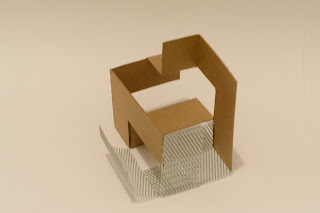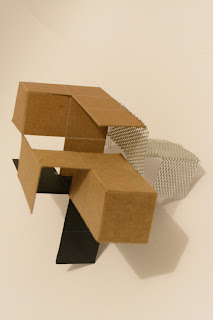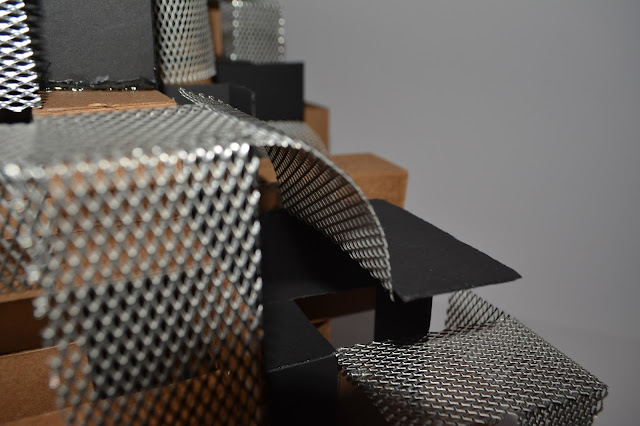Final Jury ( Transformation )
( The final jury of the first semester 2015-2016 )
the requirements of the final jury :
we were asked to use our full knowledge that we had obtained along the first semester , the hole experiences that we had involved in while solving design problems and the huge background that we had discovered while learning process about various kinds of designing and structure principles such as ( Repetition , Rhythm , Order , Hierarchy , Contrast , Light and shadow effects , Colors ..... and so on which can be observed by having a look back to my older posts.) in order to combine them under the theme of Transformation with the consideration of one of the most valuable designing principle in Architecture which is creating voids (spaces) and the flow between them . Thus , we have started with two basal elements of any shape that can be fit in (15×17) rectangle to produce elements with maximum (3) different type of Transformation ( Folding - Bending ) that can be combined together for the next stage . The most important point that had been considered in this step is to form the basal elements and control the transformation in a way that is effective to gain successful voids and connection between them . In this project , (2) basal elements were used and the shape of them was obtained by eliminating some areas in order to ensure the connection between voids that is created when the elements come together and longing some parts to serve good connection purpose ( Edge to edge connection ) and to avoid point to point connection . The elements can be described better by the photos below :
1- Basel Element A :
2- Basal Element B :
The next stage after creating elements is to combine them successfully in groups form to define different types of voids and various ways of flow connections between them . at the same time , the elements inside groups should have the ability to connect to other groups as well so they can create more voids and connection. All of these should be structured in a planned and ordered organization . These photos can show the used groups in the design :

the groups with bending elements :
1- Basel Element A :
2- Basal Element B :
The next stage after creating elements is to combine them successfully in groups form to define different types of voids and various ways of flow connections between them . at the same time , the elements inside groups should have the ability to connect to other groups as well so they can create more voids and connection. All of these should be structured in a planned and ordered organization . These photos can show the used groups in the design :

the groups with bending elements :
In this project , there are (5) different types of groups that were formed from the transformed elements , (3) of them which have the bending elements are combined together to form a bigger group ( clustered group ) . After that , each (2) clustered groups were sat together as a pair and this pair is repeated (3) times in the hole organization in such a way that each pair is rotated (90 degree ) in two directions . By this rotation , the repetition and rhythm principles had been achieved clearly in the organization . As a result of this ordered organization , (2) central voids had been defined in the design . For this point , the other two groups were used in a way to organize these voids , to reach the connection of two sides and to complete the flow of the void . By this Type of definition to the central voids , it can be said that the hierarchy principle is defined as there is a graduated ordering according to the importance of the voids and the flow between all parts of the design . the following photo can act as the diagram of the design’s organization :
From the aspect of color and material use , we were asked to use (3) types of materials that have different colors and they are ( black cardboard - brownish thick cardboard - mesh ) . the black cardboard and brownish cardboard were used to emphasize the contradictory between the basal elements as the brownish cardboard was used for all elements of basal element (A) and the black cardboard was used for all elements of basal element (B) . The clustered group connection between its pairs was designed in a way to use the same black element in each pair for the main connection between them . Mesh material was used to get the full benefit of its transparency .First of all , it was use in boundaries in order to make interior voids visible though it . Further more , it was used for applying bending transformation due to being easy to apply and to control , being at the edges of the design and being very difficult to define bending inside the design at the same way of using non-bending elements ( the undefined and uncombined diversity may considered as a weak point in the design ) .
In terms of using (bending) transformation , the bending was applied on the elements of basal elements (B) only and upon different shaped parts of the elements . By this , it was used to promote its elements to be used in different connection methods . In other words , the bending elements were used to define a specific shape that complete the flow inside one group , to connect two voids in two different groups and to connect two clustered groups by creating a big connecting void .
The final result of this can be shown as such :
















































Comments
Post a Comment